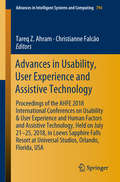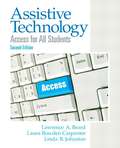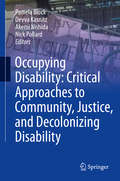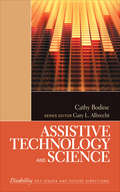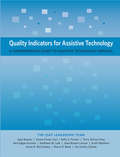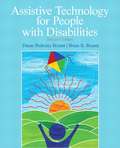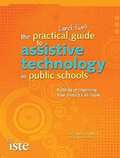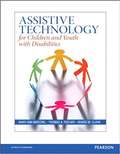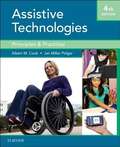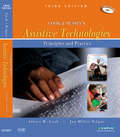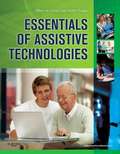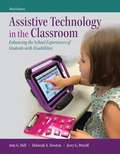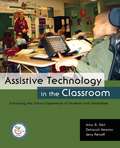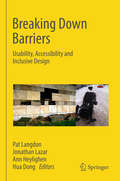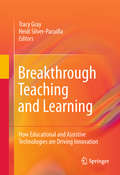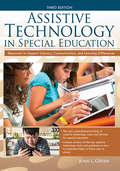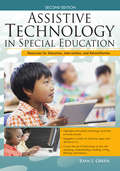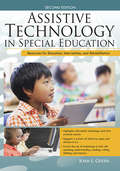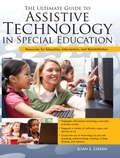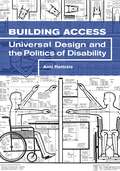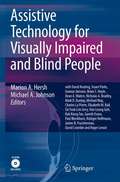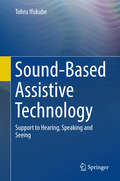Special Collections
Assistive Technology
Description: A diverse collection of textbooks detailing assistive technology for people with a diverse range of disabilities. #disability
- Table View
- List View
Advances in Usability, User Experience and Assistive Technology
by Tareq Z. Ahram and Christianne FalcãoThis book focuses on emerging issues in usability, interface design, human–computer interaction, user experience and assistive technology. It highlights research aimed at understanding human interaction with products, services and systems, and focuses on finding effective approaches for improving user experience. It also discusses key issues in designing and providing assistive devices and services to individuals with disabilities or impairment, to assist mobility, communication, positioning, environmental control and daily living. The book covers modelling as well as innovative design concepts, with a special emphasis on user-centered design, and design for specific populations, particularly the elderly. Virtual reality, digital environments, heuristic evaluation and forms of device interface feedback of (e.g. visual and haptic) are also among the topics covered. Based on the AHFE 2018 Conference on Usability & User Experience and the AHFE 2018 Conference on Human Factors and Assistive Technology, held on July 21–25, 2018, in Orlando, Florida, USA, this book reports on cutting-edge findings, research methods and user-centred evaluation approaches.
Advances in Usability, User Experience and Assistive Technology
by Christianne Falcão and Tareq Z. AhramThis book focuses on emerging issues in usability, interface design, human–computer interaction, user experience and assistive technology. It highlights research aimed at understanding human interaction with products, services and systems, and focuses on finding effective approaches for improving user experience. It also discusses key issues in designing and providing assistive devices and services to individuals with disabilities or impairment, to assist mobility, communication, positioning, environmental control and daily living. The book covers modelling as well as innovative design concepts, with a special emphasis on user-centered design, and design for specific populations, particularly the elderly. Virtual reality, digital environments, heuristic evaluation and forms of device interface feedback of (e.g. visual and haptic) are also among the topics covered. Based on the AHFE 2018 Conference on Usability & User Experience and the AHFE 2018 Conference on Human Factors and Assistive Technology, held on July 21–25, 2018, in Orlando, Florida, USA, this book reports on cutting-edge findings, research methods and user-centred evaluation approaches.
Assistive Technology
by Lawrence A. Beard and Linda B. Johnston and Laura Bowden CarpenterOrganized around the theme of universal design, this guide to assistive technology discusses the knowledge and skills educators need to know in order to determine the appropriate use of technology and services to meet the needs of individuals with disabilities. The text provides an overview and introduction to the topic of assistive technology, evaluating various technologies for classroom use, and using assistive technology with special needs students of a diverse range of disabilities, including the young child with special needs, students with high incidence disabilities, positioning and mobility for students with physical disabilities, students with communication disorders, and sensory impairments. It further discusses AT in relation to transitioning, distance learning, and the ethical standards of practice. The new edition has been thoroughly updated to reflect the most recent AT beneficial to students requiring such special accommodations, including links to websites of current AT devices, and software for use in the classroom, and a new chapter on Universal Design for Learning and Response to Intervention and how to combine the two techniques to provide students with access to the general education curriculum. This edition also features more on ethics and assistive technology use for consideration of all students, new chapter introductions, questions for reflection, end-of-chapter review material, and extended coverage of diversity related to assistive technology and the classroom. Designed to provide useful information and strategies for candidates in teacher education programs and those practicing educators, the book is also useful to and any other professional or layperson interested in assistive technology and learning for all students.
Occupying Disability
by Pamela Block and Devva Kasnitz and Akemi Nishida and Nick PollardThis book explores the concept of "occupation" in disability well beyond traditional clinical formulations of disability: it considers disability not in terms of pathology or impairment, but as a range of unique social identities and experiences that are shaped by visible or invisible diagnoses/impairments, socio-cultural perceptions and environmental barriers and offers innovative ideas on how to apply theoretical training to real world contexts. Inspired by disability justice and "Disability Occupy Wall Street / Decolonize Disability" movements in the US and related movements abroad, this book builds on politically engaged critical approaches to disability that intersect occupational therapy, disability studies and anthropology. "Occupying Disability" will provide a discursive space where the concepts of disability, culture and occupation meet critical theory, activism and the creative arts. The concept of "occupation" is intentionally a moving target in this book. Some chapters discuss occupying spaces as a form of protest or alternatively, protesting against territorial occupations. Others present occupations as framed or problematized within the fields of occupational therapy and occupational science and anthropology as engagement in meaningful activities. The contributing authors come from a variety of professional, academic and activist backgrounds to include perspectives from theory, practice and experiences of disability. Emergent themes include: all the permutations of the concept of "occupy," disability justice/decolonization, marginalization and minoritization, technology, struggle, creativity and change. This book will engage clinicians, social scientists, activists and artists in dialogues about disability as a theoretical construct and lived experience.
Assistive Technology and Science
by Cathy BodineThis volume in The SAGE Reference Series on Disability explores issues involving assistive technology engineering and science. It is one of eight volumes in the cross-disciplinary and issues-based series, which incorporates links from varied fields making up Disability Studies as volumes examine topics central to the lives of individuals with disabilities and their families. With a balance of history, theory, research, and application, specialists set out the findings and implications of research and practice for others whose current or future work involves the care and/or study of those with disabilities, as well as for the disabled themselves. The presentational style (concise and engaging) emphasizes accessibility. Taken individually, each volume sets out the fundamentals of the topic it addresses, accompanied by compiled data and statistics, recommended further readings, a guide to organizations and associations, and other annotated resources, thus providing the ideal introductory platform and gateway for further study. Taken together, the series represents both a survey of major disability issues and a guide to new directions and trends and contemporary resources in the field as a whole.
Quality Indicators for Assistive Technology
by Susan Mccloskey and Diana Foster Carl and Gayl Bowser and Jane Edgar Korsten and Joan Breslin Larson and Joy Smiley Zabala and Kathleen Lalk and Kelly Fonner and Penny Reed and Scott Marfilius and Terry Vernon FossMore than 6 million children with disabilities in North America require assistive technology and related services each year in order to participate and succeed in school. This book, Quality Indicators for Assistive Technology, provides an essential guide for assessing a child's needs, choosing and implementing the right technologies and services, and training education professionals in how to optimize learning with these critical tools.
Assistive Technology For People With Disabilities (Second Edition)
by Diane Pedrotty Bryant and Brian R. BryantAssistive Technology for People with Disabilities, Second Edition, includes eight comprehensive chapters that focus on devices and software to enhance the lives and promote the independence of people with disabilities. Updated with new research, content and features to address current developments in the field, the book approaches assistive technology and education in a lifespan, multidisciplinary manner by discussing the use of current technology in the fields of special education, rehabilitation, speech-language pathology, and other disciplines. Featured devices and software will help you understand how areas such as mobility, communication, education, independent living, and access to information media affect learning and living for individuals with disabilities. You will also gain a great understanding of the foundational and historical perspectives of AT, assessment, universal design, and the ADAPT framework, which is a tool to help educators make decisions about appropriate AT, student needs, and the demands of the environment. Developed from the authors' years of experience teaching both K-12 students and adults, as well as their own framework for understanding assistive technology application and integrating technology into instruction, this new edition addresses assistive technology that promotes knowledge and skills, practical application and a myriad of opportunities that good technology provides for persons with disabilities.
The Practical (and Fun) Guide to Assistive Technology in Public Schools
by Christopher R. Bugaj and Sally Norton-DarrAssistive technology (AT) is a serious topic, but reading about it doesn't have to be boring! In this essential reference, authors Christopher R. Bugaj and Sally Norton-Darr throw in a few pirates, monsters, and monkeys to keep you engaged but don't sacrifice the tips, strategies, and insight that will help improve your school or district AT program. From setting up a stellar team to consultations and evaluations, and from implementation to assessing success, this guide presents detailed advice and ideas to provide AT services that effectively and efficiently help students. The nuts and bolts of each area are presented in a practical way (with amusing metaphors thrown in for good measure) so that you can directly apply what's in the book and see tangible results. Educators new to AT will find the step-by-step layout help in building an AT team and procedures, while seasoned AT professionals will find value in the fresh ideas on reducing paperwork, expanding an AT team, and strategies for considering AT for all students. Christopher R. Bugaj, an assistive technology trainer, is a founding member of the AT team for Loudoun County Public Schools in Virginia. He also works as an adjunct professor for George Mason University and is the host and producer of the award-winning podcast series A.T. TIPS cast. Sally Norton-Darr is an assistive technology trainer for Loudoun County Public Schools and a nationally certified speech-language pathologist. She presents on high- and low-tech AT topics both nationally and regionally. AUDIENCE: Administrators (K-12), assistive technology professionals, special education staff. FEATURES: Guides AT professionals through the steps of setting up a successful AT program. Information on AT, IEPs, and the law. Advice and ideas for working successfully with all stakeholders, including teachers, parents, service providers, IEP teams, and students. TECHNOLOGY: This material is suitable for any platform.
Assistive Technology For Children And Youth With Disabilities
by Mary Ann Marchel and Denise M. Clark and Thomas A. FischerEncompassing home, school and community environments, Assistive Technology for Children and Youth with Disabilities highlights the vast amount of supports available for children with disabilities from birth to age 21. An informative resource, the text details not only what types of assistive technology exist, but also how to select technology to meet specific students needs and match specific environmental circumstances. Chapters address the broad range of technologies now available, including supports for mobility, positioning, access, academic areas, behavior problems, recreation, and transitioning. Case examples, vignettes and activities provide practical, real-life examples that show how to use assistive technology to improve the independence and participation of students with special needs.
Assistive Technologies
by Albert M. Cook and Janice Miller PolgarIt's here: the latest edition of the one text you need to master assistive strategies, make confident clinical decisions, and help improve the quality of life for people with disabilities. Based on the Human Activity Assistive Technology (HAAT) model, Assistive Technologies: Principles and Practice, 4th Edition provides detailed coverage of the broad range of devices, services, and practices that comprise assistive technology, and focuses on the relationship between the human user and the assisted activity within specific contexts. Updated and expanded, this new edition features coverage of new ethical issues, more explicit applications of the HAAT model, and a variety of global issues highlighting technology applications and service delivery in developing countries. Human Activity Assistive Technology (HAAT) framework demonstrates assistive technology within common, everyday contexts for more relevant application. Focus on clinical application guides you in applying concepts to real-world situations. Review questions and chapter summaries in each chapter help you assess your understanding and identify areas where more study is needed. Content on the impact of AT on children and the role of AT in play and education for children with disabilities demonstrates how AT can be used for early intervention and to enhance development. Coverage of changing AT needs throughout the lifespan emphasizes how AT fits into people's lives and contributes to their full participation in society. Principles and practice of assistive technology provides the foundation for effective decision-making. NEW! Global issues content broadens the focus of application beyond North America to include technology applications and service delivery in developing countries. NEW! Ethical issues and occupational justice content exposes you to vital information as you start interacting with clients. NEW! More case studies added throughout the text foster an understanding of how assistive technologies are used and how they function. NEW! Updated content reflects current technology and helps keep you current. NEW! Explicit applications of the HAAT model in each of the chapters on specific technologies and more emphasis on the interactions among the elements make content even easier to understand.
Cook and Hussey's Assistive Technologies
by Albert M. Cook and Janice Miller PolgarMaster the assistive strategies you need to make confident clinical decisions and help improve the quality of life for people with disabilities with the latest edition of this comprehensive text. Based on the Human Activity Assistive Technology (HAAT) model developed by the authors, the book provides detailed coverage of the broad range of devices, services, and practices that comprise assistive technology and focuses on the relationship between the human user and the assisted activity within specific contexts. This title includes additional digital media when purchased in print format. For this digital book edition, media content may not be included
Cook and Hussey's Assistive Technologies
by Albert M. Cook and Janice Miller PolgarMaster the assistive strategies you need to make confident clinical decisions and help improve the quality of life for people with disabilities with the latest edition of this comprehensive text. Based on the Human Activity Assistive Technology (HAAT) model developed by the authors, the book provides detailed coverage of the broad range of devices, services, and practices that comprise assistive technology and focuses on the relationship between the human user and the assisted activity within specific contexts. This new edition has been expanded and updated, and features new multimedia components that further demonstrate how to apply the concepts you've learned to real-world practice. Focus on clinical application guides you in applying concepts to real-world situations. Human Activity Assistive Technology (HAAT) framework demonstrates assistive technology within common, everyday contexts for more relevant application. Review questions and chapter summaries in each chapter help you assess your understanding and identify areas where more study is needed. Assistive Technology for Cognitive Augmentation chapter gives you a foundation in the growing use of assistive technology to enhance human cognitive processes. Technologies that Aid Transportation familiarizes you with the many options of transportation assistance available and helps you determine which are right for your clients. Separate chapters on sensory aid for visual and auditory impairment provide additional strategies in these key assistive areas. Bound-in companion CD-ROM features videos of assessment and device use that helps you visualize procedures and reinforce your clinical application skills. Evolve resources test your understanding of terms and concepts and link you to supplemental sources for further research. Additional case studies throughout the text prepare you for practice with realistic client scenarios. Expanded evidence-based content supports concepts with real-world research data. Additional photographs, illustrations, tables, and boxes provide clear visual references and quick access to important information.
Essentials of Assistive Technologies
by Albert M. Cook and Jan Millar PolgarMaster the assistive strategies you need to make confident clinical decisions and help improve the quality of life for people with disabilities with this new essentials text. Based on the Human Activity Assistive Technology (HAAT) model developed by Dr. Cook, the book provides the most important coverage of the devices, services, and practices that comprise assistive technology and focuses on the relationship between the human user and the assisted activity within specific contexts. Case studies, illustrations of assistive devices, review questions, and well-developed learning objectives help you focus on the most important areas of assistive technology application.
Assistive Technology in the Classroom
by Amy G. Dell and Deborah A. Newton and Jerry G. PetroffWith an emphasis on the integration of assistive technology into the curriculum, this text focuses on how assistive technology can be used in schools to enhance the teaching and learning of students with disabilities. This link between technology and teaching and learning drives the book's organization as well as its content. It is organized by school-related tasks that students must perform on a daily basis to be successful -- reading, writing, practicing academic skills, and communicating with their teachers and peers – and presents descriptions of technology-based solutions to the obstacles students with disabilities face in completing these tasks. Since being able to access computers is one major barrier, the text features a section on making computers accessible to students with a wide range of disabilities. A companion web site offers up-to-date information on product names, vendors, web site addresses, and other time-sensitive material.
Assistive Technology in the Classroom
by Amy G. Dell and Deborah A. Newton and Jerry G. PetroffWith an emphasis on the integration of assistive technology into the curriculum, this text focuses on how assistive technology can be used in schools to enhance the teaching and learning of students with disabilities.
Breaking Down Barriers
by Pat Langdon and Jonathan Lazar and Ann Heylighen and Hua DongThe Cambridge Workshops on Universal Access and Assistive Technology (CWUAAT) is one of the few gatherings where people interested in inclusive design, across different fields, including designers, computer scientists, engineers, architects, ergonomists, ethnographers, policymakers and user communities, meet, discuss, and collaborate. CWUAAT has also become an international workshop, representing diverse cultures including Portugal, Germany, Trinidad and Tobago, Canada, Australia, China, Norway, USA, Belgium, UK, and many more. The workshop has five main themes based on barriers identified in the developing field of design for inclusion: I Breaking Down Barriers between Disciplines II Breaking Down Barriers between Users, Designers and Developers III Removing Barriers to Usability, Accessibility and Inclusive Design IV Breaking Down Barriers between People with Impairments and Those without V Breaking Down Barriers between Research and Policy-making In the context of developing demographic changes leading to greater numbers of older people and people living with impairments, the general field of inclusive design research strives to relate the capabilities of the population to the design of products, services, and spaces. CWUAAT has always had a successful multidisciplinary focus, but if genuine transdisciplinary fields are to evolve from this, the final barriers to integrated research must be identified and characterised. Only then will benefits be realised in an inclusive society. Barriers do not arise from impairments themselves, but instead, are erected by humans, who often have not considered a greater variation in sensory, cognitive and physical user capabilities. Barriers are not only technical or architectural, but they also exist between different communities of professionals. Our continual goal with the CWUAAT workshop series is to break down barriers in technical, physical, and architectural design, as well as barriers between different professional communities.
Breaking Down Barriers
by Hua Dong and Ann Heylighen and Jonathan Lazar and Pat LangdonThe Cambridge Workshops on Universal Access and Assistive Technology (CWUAAT) is one of the few gatherings where people interested in inclusive design, across different fields, including designers, computer scientists, engineers, architects, ergonomists, ethnographers, policymakers and user communities, meet, discuss, and collaborate. CWUAAT has also become an international workshop, representing diverse cultures including Portugal, Germany, Trinidad and Tobago, Canada, Australia, China, Norway, USA, Belgium, UK, and many more. The workshop has five main themes based on barriers identified in the developing field of design for inclusion: I Breaking Down Barriers between Disciplines II Breaking Down Barriers between Users, Designers and Developers III Removing Barriers to Usability, Accessibility and Inclusive Design IV Breaking Down Barriers between People with Impairments and Those without V Breaking Down Barriers between Research and Policy-making In the context of developing demographic changes leading to greater numbers of older people and people living with impairments, the general field of inclusive design research strives to relate the capabilities of the population to the design of products, services, and spaces. CWUAAT has always had a successful multidisciplinary focus, but if genuine transdisciplinary fields are to evolve from this, the final barriers to integrated research must be identified and characterised. Only then will benefits be realised in an inclusive society. Barriers do not arise from impairments themselves, but instead, are erected by humans, who often have not considered a greater variation in sensory, cognitive and physical user capabilities. Barriers are not only technical or architectural, but they also exist between different communities of professionals. Our continual goal with the CWUAAT workshop series is to break down barriers in technical, physical, and architectural design, as well as barriers between different professional communities.
Breakthrough Teaching and Learning
by Tracy Gray and Heidi Silver-PacuillaThe many technology-related educational changes of the past decade have been propelled by even greater changes in the general consumer technology landscape. Education has become increasingly entwined with the digital consumer landscape. We are no longer asking whether digital materials and tools should be integrated into teaching and learning, but how and how well. Meanwhile, the overall academic performance of U.S. students has not kept pace with our international peers. Many policymakers have called for increased attention to students' 21st century skills and work readiness, pointing to the critical role technology should play in educational innovation. These changes mean that many mainstream accessible technologies can be used in the classroom to benefit a diverse population of learners, including students with disabilities and English language learners, reflecting the national shift from separate special education programs to more inclusive classrooms. Changes to policies and standards have pushed assistive and accessible technologies to the forefront, including the Higher Education Opportunity Act of 2008, which requires teacher preparation programs to address educational technology and principles of universal design for learning (UDL), and the National Instructional Materials Accessibility Standard (NIMAS), which creates a public-private infrastructure to provide more timely delivery of digital text to students with physical and print disabilities. This volume represents pioneering ideas that examine how accessible educational technologies can be harnessed for breakthrough learning for all students. Chapters will cover innovation trends in educational and assistive technologies, cognitive and neuroscience findings on how individual differences impact technology use and choice; the intersection of educational, leisure, health habits and exer-gaming; the use of social networking tools by students with and without disabilities; the use of social networking for teacher professional learning communities; the future of assessments for decision-making; and an analysis of the habits of mind and work traits of innovators NCTI has interviewed over the past five years.
Assistive Technology in Special Education
by Joan GreenAssistive Technology in Special Education presents a wealth of practical, well-organized information to help families, teachers, and therapists find effective solutions for students with learning, literacy, and cognitive challenges. This third edition features new affordable tools to improve and compensate for challenges related to speaking, understanding, reading, writing, and thinking and remembering, as well as strategies to help students become more organized and efficient. Also highlighted are iDevices, G Suite (Google Apps and Extensions), online collaborative sites, and features built into the computers and mobile devices readers already use. As technology changes and new operating systems make older programs obsolete, this book will empower readers to explore the most current resources as they become available.
Assistive Technology in Special Education
by Joan GreenFamilies, teachers, and therapists who are searching for an update about how to use the latest technologies to help individuals who struggle with communication, literacy, and learning will benefit from the wealth of practical, well-organized information in this second edition of Assistive Technology in Special Education. The indexed update presents an overview of the uses of technologies to help readers zero in on specific, powerful, cutting-edge resources they can use to enhance success. The book features new tools to improve and compensate for challenges relating to speaking, understanding, reading, writing, thinking and remembering, as well as strategies to help students become more organized and efficient. The use of tablets such as the iPad and smartphones, as well as cloud-based products, are highlighted. Online resources and social networking tools are presented to empower readers to learn about new products as they become available.
Assistive Technology In Special Education
by Joan GreenFamilies, teachers, and therapists who are searching for an update about how to use the latest technologies to help individuals who struggle with communication, literacy, and learning will benefit from the wealth of practical, well-organized information in this second edition of Assistive Technology in Special Education. The indexed update presents an overview of the uses of technologies to help readers zero in on specific, powerful, cutting-edge resources they can use to enhance success. The book features new tools to improve and compensate for challenges relating to speaking, understanding, reading, writing, thinking and remembering, as well as strategies to help students become more organized and efficient. The use of tablets such as the iPad and smartphones, as well as cloud-based products, are highlighted. Online resources and social networking tools are presented to empower readers to learn about new products as they become available.
The Ultimate Guide to Assistive Technology in Special Education
by Joan L. GreenGreen, a speech-language pathologist, presents a guide for parents, teachers, therapists, and others to using assistive technology in special education classrooms to improve the communication, literacy, and learning of students with disabilities. After introducing computers and software and the benefits of this technology, she outlines specific tools for verbal and written expression, auditory and reading comprehension, reading skills, cognition, learning, and memory, with information on websites, features, operating systems, and price. She includes games and free online interactive activities, Internet communication and learning tools, and adapted email, search engines, and web browsers. There is no index. Annotation ©2011 Book News, Inc. , Portland, OR (booknews. com)
Building Access
by Aimi Hamraie“All too often,” wrote disabled architect Ronald Mace, “designers don’t take the needs of disabled and elderly people into account.” Building Access investigates twentieth-century strategies for designing the world with disability in mind. Commonly understood in terms of curb cuts, automatic doors, Braille signs, and flexible kitchens, Universal Design purported to create a built environment for everyone, not only the average citizen. But who counts as “everyone,” Aimi Hamraie asks, and how can designers know? Blending technoscience studies and design history with critical disability, race, and feminist theories, Building Access interrogates the historical, cultural, and theoretical contexts for these questions, offering a groundbreaking critical history of Universal Design. Hamraie reveals that the twentieth-century shift from “design for the average” to “design for all” took place through liberal political, economic, and scientific structures concerned with defining the disabled user and designing in its name. Tracing the co-evolution of accessible design for disabled veterans, a radical disability maker movement, disability rights law, and strategies for diversifying the architecture profession, Hamraie shows that Universal Design was not just an approach to creating new products or spaces, but also a sustained, understated activist movement challenging dominant understandings of disability in architecture, medicine, and society.Illustrated with a wealth of rare archival materials, Building Access brings together scientific, social, and political histories in what is not only the pioneering critical account of Universal Design but also a deep engagement with the politics of knowing, making, and belonging in twentieth-century United States.
Assistive Technology for Visually Impaired and Blind People
by Marion A. Hersh and Michael A. JohnsonEqual accessibility to public places and services is now required by law in many countries. In the case of the vision-impaired, it is often the use of specialised technology which can provide them with a fuller enjoyment of all the facilities of society from large scale meetings and public entertainments to the more personal level of reading a book or making music. In this volume the engineering and design principles and techniques used in assistive technology for blind and vision-impaired people are explained. Features:· instruction in the physiology of the human visual system and methods of measuring visual ability;· explanation of many devices designed for every-day living in terms of generic electrical engineering principles;· sections of practical projects and investigations which will give the reader ideas for student work and for self teaching;· contributions by authors of international repute from divers fields which co-operate under the banner of assistive technology, among them: artificial vision systems; psychology, haptics, electrical engineering, design and visual physiology. Assistive Technology for Vision-impaired and Blind People is an an effective means of maintaining the currency of knowledge for engineers and health workers working to provide devices and/or services for people with sight loss and an excellent source of reference for students working in assistive technology and rehabilitation.
Sound-Based Assistive Technology
by Tohru IfukubeThis book presents a technology to help speech-, hearing- and sight-impaired people. It explains how they will benefit from an enhancement in their ability to recognize and produce speech or to detect sounds in their surroundings. Additionally, it is considered how sound-based assistive technology might be applied to the areas of speech recognition, speech synthesis, environmental recognition, virtual reality and robots. The primary focus of this book is to provide an understanding of both the methodology and basic concepts of assistive technology rather than listing the variety of assistive devices developed. This book presents a number of different topics which are sufficiently independent from one another that the reader may begin at any chapter without lacking background information. Much of the research quoted in this book was conducted in the author's laboratories at Hokkaido University and University of Tokyo. This book offers the reader a better understanding of a number of unsolved problems that still persist in the field of sound-based assistive technology.
